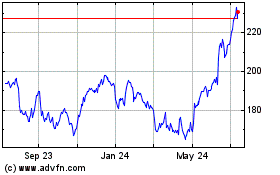FBI Discovers al Qaeda Link in Pensacola Attack -- 3rd Update
May 18 2020 - 12:18PM
Dow Jones News
By Sadie Gurman and Dustin Volz
The Saudi aviation student who killed three people at a Florida
Navy base last year was in touch with a suspected al Qaeda
operative, a person familiar with the investigation said, a
discovery authorities made based on information found in the
gunman's locked iPhones.
Second Lt. Mohammed Alshamrani, a member of the Saudi air force
who was training with the U.S. military, posted anti-U.S. messages
on social media about two hours before he opened fire in a
classroom at Naval Air Station Pensacola on Dec. 6, officials have
said.
Attorney General William Barr called the attack an act of
terrorism and pressured Apple Inc. to help unlock a pair of the
gunman's iPhones that he said could provide more information about
his radicalization.
The Federal Bureau of Investigation, bypassing Apple's security
features, was ultimately able to access information on at least one
of two phones, the person said, and found that the gunman had
communicated with the suspected al Qaeda operative.
At a news conference Monday, FBI Director Christopher Wray said
law enforcement received "effectively no help" from Apple in their
probe, delaying the investigation and potentially jeopardizing
public safety.
"Because the crucial evidence on the killer's phones was kept
from us, we did all that investigating not knowing what we do now,
valuable intelligence about what to ask," Mr. Wray said. "If we
had, that around-the-clock, all-hands-on-deck effort would have
been a lot more productive."
The FBI declined to comment on the al Qaeda link.
During the attack, Alshamrani made statements critical of U.S.
military actions overseas and fired shots at a picture of President
Trump, officials said. In the weeks beforehand, the gunman used
social media to blame the U.S. for crimes against Muslims,
officials said, issuing a warning on the anniversary of the Sept.
11, 2001, terrorist attacks that "the countdown has started."
It wasn't immediately known whether the suspected al Qaeda
operative directed the shooting, which also left eight injured and
prompted the expulsion of 21 Saudi military students from a
training program. Alshamrani was killed by responding sheriff's
deputies.
Mr. Barr's January request of Apple jump-started a
long-simmering fight between law enforcement and Silicon Valley
over encryption technology. Mr. Barr said Apple didn't provide any
"substantive assistance" to break into two phones belonging to the
gunman, which were locked with unknown pass codes and
encrypted.
Apple countered at the time that it had provided timely and
thorough answers to the Justice Department's requests for help in
the investigation and provided a "wide variety of information" to
law enforcement, including iCloud backup data and account and
transactional information.
But Mr. Barr said that only a look at data and communications on
the gunman's phones could help them say for certain whether he
discussed his plans with others.
Mobile-phone security experts said at the time that the FBI
could likely work with a third-party vendor to unlock the phone, as
it had done in previous cases. Apple didn't immediately respond to
a request for comment Monday.
The connection to al Qaeda will also pose a challenge for the
FBI, which has been focused in recent years on trying to stop
attacks inspired by Islamic State. Mr. Wray told lawmakers earlier
this year that the FBI remains concerned that al Qaeda intends to
carry out large-scale attacks in the U.S.
"Al Qaeda maintains its desire for large scale spectacular
attacks," Mr. Wray said in February, adding that sustained
counterterrorism pressure has degraded the group's
Afghanistan-Pakistan senior leadership. "So in the near term, al
Qaeda is more likely to focus on building its international
affiliates and supporting small-scale, readily achievable attacks
in key regions such as East and West Africa. Simultaneously, over
the last year, propaganda from al Qaeda leaders seeks to inspire
individuals to conduct their own attacks in the U.S. and the
West."
Write to Sadie Gurman at sadie.gurman@wsj.com and Dustin Volz at
dustin.volz@wsj.com
(END) Dow Jones Newswires
May 18, 2020 12:03 ET (16:03 GMT)
Copyright (c) 2020 Dow Jones & Company, Inc.
Apple (NASDAQ:AAPL)
Historical Stock Chart
From Mar 2024 to Apr 2024

Apple (NASDAQ:AAPL)
Historical Stock Chart
From Apr 2023 to Apr 2024
